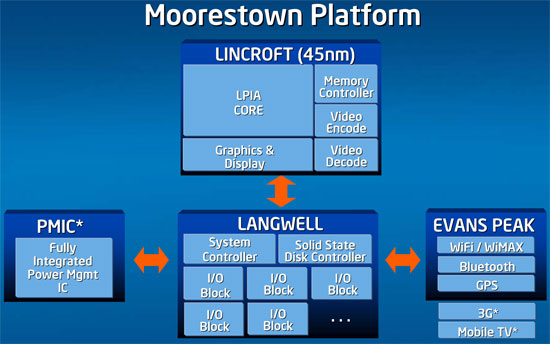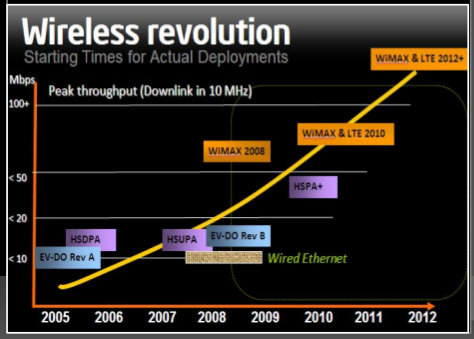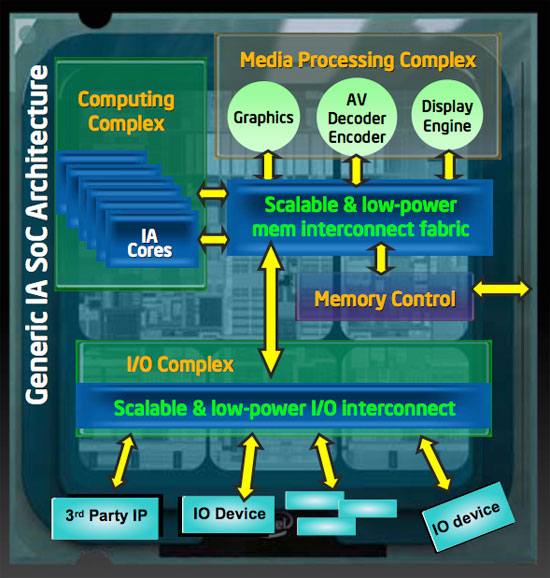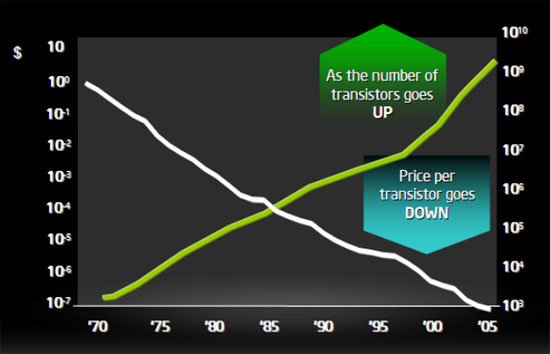Intel's SoC Update: 1B Transistors Embedded in 5 Years
by Anand Lal Shimpi on July 24, 2008 12:00 AM EST- Posted in
- CPUs
Moorestown Recap and Update: 1B Transistors in your Pocket, in 5 Years
The Atom processor is just that, a standalone CPU. It has no integrated memory controller, much less on-die graphics or anything else that would make it feasible for use in something like a smartphone.
Atom’s mobile chipset counterpart, codenamed Poulsbo, is built on a very old 130nm manufacturing process, which unfortunately means that it’s huge:

The Intel Atom processor (left) vs. The Poulsbo chipset (right)
The physical size of the Atom/Poulsbo combination is just too large and the leakage power of the platform is too great to allow for multi-day standby battery life, which is necessary for something like a smartphone.
Intel’s answer comes by 2010 with Moorestown:

Moorestown is the System on a Chip (SoC) successor to Atom, addressing many of the deficiencies mentioned above. Built entirely on a 45nm process, Moorestown combines Atom with a memory controller, GPU and dedicated video encode/decode hardware. The new chip is called Lincroft and should boast reductions in physical size and power consumption, making it the first x86 platform ready for use in smartphones.
Intel revealed a bit more today about Moorestown, mostly highlighting the need for it.
Wireless bandwidth is increasing:

Just give me 10Mbps wirelessly by 2009 and I'll be happy
The types of things we’re trying to do online are also increasing in complexity:

Intel seems to imply that future SoCs will be made up of > 100M transistors, and it would be safe to say that the Lincroft chip in Moorestown could easily be a 100M transistor chip. The Atom processor itself is 47M transistors, integrating a memory controller, GPU and video encode/decode engines could easily see that balloon to 100M transistors.

Even more exciting is that within 5 years Intel expects embedded processors like Lincroft to have 1 billion transistors. That would mean something with the complexity of Nehalem, in something the size of an iPhone...in 5 years.

Moore's Law at its best. Not only do things get faster, less complex chips get much cheaper.










13 Comments
View All Comments
sanghab - Wednesday, July 30, 2008 - link
Canmore is not a crude design. It is a second generation SoC for media playback. It's predecessor, the CE2210 was definitely a cruder device and based on an XScale processor. Canmore is highly capable, IA based, and able to decode any video standard, any audio standard or handle multiple HD streams to display and across a home network. It is equally at home handling cable, decoding blu-ray, managing dvr streams and indexing, or working as part of a connected consumer's digital home.wonwhole - Sunday, July 27, 2008 - link
???????ATOM?wonwhole - Sunday, July 27, 2008 - link
????????????When will ATOM go into mobile-phone?
whatthehey - Sunday, July 27, 2008 - link
Can you read? Because I think that was the point of the article, that Moorestown is necessary to make mobile phones an option. The current Atom is way too power hungry, and even worse is that the chipset for it is larger than the CPU (what with the 130nm process). I'd figure on two years minimum before Atom gets into anything like a smartphone.TonyB - Thursday, July 24, 2008 - link
but can it play Crysis?helldrell666 - Thursday, July 24, 2008 - link
in order to open a jpeg file with an eepc you need 24 seconds and 100% of your cpu usage.bla bla bla.
I know this site is funded by INTEL and probably nvidia.
SO, im not gonna complain.
Kepp the good sh. anandtech
lealwai - Thursday, July 24, 2008 - link
.... huh?I don't think he was touting the performance of an eeepc with atom. Merely stating that they were being used. yet, you bring up a totally unrelated point...
JEDIYoda - Thursday, July 24, 2008 - link
AMD fanboi`s tend to do that...JWalk - Friday, July 25, 2008 - link
Fanbois in general tend to do that. If you aren't cheering for their "favorite" company or product, then you must be against them. And then you must be yelled at. Ah, the fun side of the interwebs. ;)Eri Hyva - Thursday, July 24, 2008 - link
1W is totally reasonable in > 1,5GHz with 32nmhttp://www.physorg.com/news109344893.html">http://www.physorg.com/news109344893.html